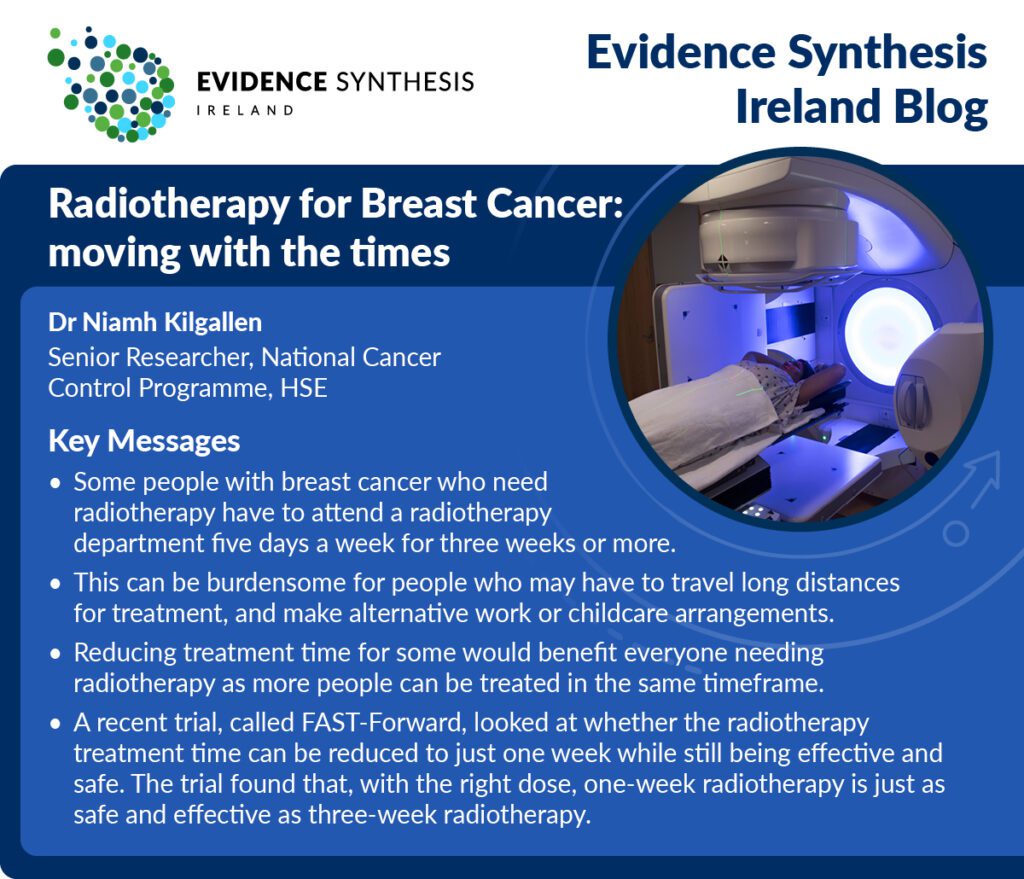In this blog for people with breast cancer and their families, Dr Niamh Kilgallen, a Senior Researcher with the National Cancer Control Programme in the Health Service Executive, looks at the latest evidence on radiotherapy treatment for breast cancer and asks if the treatment time for radiotherapy can safely be reduced to one week.

Every year in Ireland around 3,400 people are diagnosed with breast cancer, and many of these will be treated with radiotherapy after their surgery. Last year, we updated the National Cancer Control Programme (NCCP) guidelines for treating breast cancer with radiotherapy in Ireland. One of the most impactful new recommendations relates to the treatment time for radiotherapy. The updated guideline recommends that some people who are having breast radiotherapy should be considered for a course of radiotherapy that lasts just one week.
Think of radiotherapy as if it’s a drug. Just like a drug, radiotherapy is prescribed in specific doses. This dose is measured in units called Gray (Gy), and the overall dose to be delivered is broken up into smaller daily doses called fractions.
Not so long ago, a person with breast cancer who was having radiotherapy would have been prescribed a radiotherapy dose of 50Gy to treat their disease, and this was given in individual doses of 2Gy over 25 fractions. To have their full course of treatment, that person had to attend a radiotherapy department five days a week, for five weeks.
Based on the evidence available at the time, the original NCCP Breast Cancer Guideline, published in 2015, recommended that this five-week schedule could be reduced to a three-week schedule for patients with early breast cancer – that is breast cancer that has not spread beyond the breast or nearby lymph nodes. However, even three weeks is still a long time. A person’s nearest radiotherapy centre might be hours away from where they live. They might have to take time away from work and family life every day to go there. Some people may have to find and pay for childcare. All of this can add a financial burden to an already stressful situation.
What if we could shorten the treatment time even more?
Imagine, then, that you could reduce the treatment time even further. You could give someone a slightly higher daily dose but over a shorter timeframe of one week. You could give someone back time and money — and you could also give time and money back to the radiotherapy centres. Reducing the treatment time for one person means that another person could be treated in that time slot.
In fact, in a study carried out over six months across the Dublin radiotherapy centres, moving 135 people with breast cancer from a 3-week schedule to a 1-week schedule saved over 1485 hospital visits, and freed up over 350 hours on the radiotherapy machine.
But is reducing treatment time safe and what else is there to consider?
When recommending any changes, it is important to weigh up the potential benefits and harms. Like all treatments, radiotherapy can have side effects. These can range from mild, short-lived changes such as reddening of the skin, to more serious, long-term problems like damage to the heart and lungs. It is important then to ensure that any change to the radiotherapy schedule will not result in a higher risk of more severe or longer-lasting side effects. It is also essential to make sure that the new treatment is at least as good as the old treatment at controlling the disease.
When writing the guideline, we looked at a trial called FAST-Forward, which was designed to show if radiotherapy could safely be given within one week while remaining as effective at controlling the cancer as a 3-week schedule. The researchers in this trial looked at the outcomes of over 4000 patients over five years after they completed their treatment. They found that, compared with people who had received 40Gy in three weeks, patients who received 26Gy in one week were no more likely to have experienced a recurrence of their cancer. The trial also showed that the side effects of the treatment were comparable between these two schedules.
Sounds great, so why only recommend it for some people?
The evidence for treating people on a 1-week radiotherapy schedule is based on the FAST-Forward trial. This trial initially looked at people who were having radiotherapy to their whole breast, but not their lymph nodes, and the results published so far reflect this. For that reason, we limited the recommendation for a 1-week schedule to people who are having whole breast radiotherapy, but no radiotherapy to their lymph nodes.
The design of the FAST-Forward trial was later changed to include people who were also receiving radiotherapy to their lymph nodes in addition to their breast. The trial is ongoing, and the researchers plan on reporting the results for this group of people once they have collected enough data.
Deciding what’s best for you
If you, or someone close to you, have been diagnosed with breast cancer then there is a good chance that radiotherapy will form part of your treatment. What radiotherapy schedule is prescribed, if any, depends on a few factors, such as how advanced the cancer is and what other treatments may be involved. Your doctor will discuss all of this with you. It can be useful to write down any specific questions that you have to help shape that discussion.




